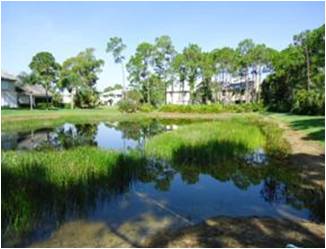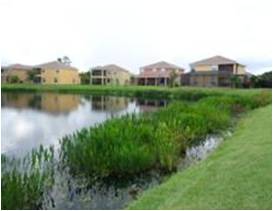Importance of Littoral Plants:
A littoral plant can be defined as any aquatic plant along a lake shoreline. These littoral zones provide a key habitat for wading birds, fish, and other aquatic invertebrate to forage or to find refuge within. Water quality has been a major issue here in Southwest Florida and littorals act as a filter marsh to improve water quality. These aquatic plants also help stabilize lake shorelines, which can prevent dangerous erosion problems. Finally, the plants can provide an aesthetically pleasing view with its array of flowers ranging in colors and natural beauty.
Land Development Code Requirements:
The Lee County
Land Development Code (LDC) requires all surface water management systems to mimic the function of natural systems, which include improving water quality, stabilizing shorelines and providing habitat for a variety of aquatic species.

Littorals must be selected based upon expected water level fluctuations and maximum water depths.
Component of a lake require:
- Four native species
- Planted Littoral Shelf
- Proper maintenance practices, including long-term maintenance
Refer to
LDC Chapter 10, Section 418 for more details.
Bulkheads, Riprap, and Other Hardened Structures:
Bulkheads, riprap revetments or other hardened shoreline structures within individual lakes require special approvals and permits.
Refer to
LDC Chapter 10, Section 418 for more details.
Deep Lake Management Plan:
A deep lake management plan is required if a lake exceeds a depth greater than 12 feet. The components of a Deep Lake Management Plan include such items as:
- Bathymetric Survey
- Deep Lake Shade Trees
- Destratification system (Lake aerators)
- Ownership of Deep Lake Management Plan
Refer to
LDC Chapter 10, Section 329(d)(3) for more details.
Common Aquatic Trees, Shrubs, and Littoral Species:
- Arrowhead (Sagittaria latifolia) Zone B
- Blue Flag Iris (Iris virginicus) Zone C
- Cordgrass (Spartina bakeri) Zone D
- Golden Canna (Canna flaccida) Zone C
- Muhly Grass (Muhlenbergia capillaries) Zone D
- Red Maple (Acer rubrum) Zone C
| - Bald Cypress (Taxodium distichum) Zone C
- Bulrush (Scirpus spp) Zone A
- Fireflag (Thalia geniculata) Zone B
- Live Oak (Quercus virginana) Zone D
- Pickerelweed (Pontederia cordata) Zone A
- Spikerush (Eleocharis spp) Zone A
|
View a more complete list of species.